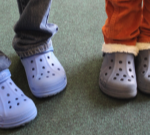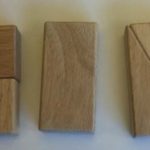Where’s The Math?
Math is a natural way of thinking and making sense of the world. Mathematical situations arise every day. You have to be ready to notice the math all around us and to engage children in doing and talking about math. Attribute is a mathematical idea that arises very early. Attributes are properties or qualities that allow us to describe & classify the world around us. We perceive attributes of the world around us through our senses. Attributes can be used to group. Attributes can be described with increasing precision.
What might you see or hear if children are thinking mathematically about attribute? They might be matching objects, describing objects or sorting objects. They might be paying attention to color or shape or size or texture. If you notice children noticing and using attributes, you might ask them: Why do these go together? Why do these not go together?
When adults are comfortable talking about math, children will share ideas without prompting. Here’s an example from a preschool classroom:
Chris & Tracy approach their teacher with excitement: “Look, our shoes are the same so they are a group! There are 4 shoes, 1, 2, 3, 4 … It is a group of shoes with holes”
Teacher: “I see you have a group of 4 shoes with holes. My shoes have little holes on the strap where I buckle the shoes. Can my shoes be part of your group?”
Chris & Tracy: “No, teacher, you have to have big holes all over to be in our group”
Teacher: “I see … you have made a group of shoes with big holes all over. Does anyone else have shoes that belong to your group?”
In a kindergarten classroom, a child runs up to the teacher and says, “A triangle equals a square!” Some teachers might say, “What do you mean? Triangles have 3 sides, and squares have 4. They’re not the same.” However, this mathematically sensitive teacher says, “What do you mean?” The child answers, “Come see!” The child leads the teacher over to the block area, where there are a lot of unit blocks for the children to play with. (Do blocks give you an idea of what the child might be thinking?) This is what the child showed the teacher:
Two square blocks can be put together to make the same shape as one longer rectangle block.
Two long triangle blocks can also be put together to make the same size rectangle shape.
Therefore, one of the squares takes up the same space as one of the triangles. In other words, they are worth the same, or, as the child says, they are “equal.”
This child was thinking hard about both the attributes of these shapes and the relationships between them. One might even say that the child was doing algebra, because they were using equivalences:
2S = R and 2T = R Therefore, 2S = 2T Therefore, S = T
In both of these scenarios, the teachers are building the children’s understanding of foundational mathematical ideas and their confidence in using math to make sense of their world.
I hope that you will be open to the joy of finding math any time, anywhere with the children in your life!

